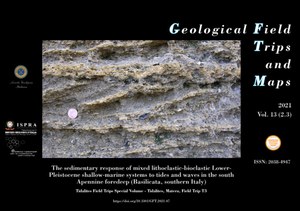The sedimentary response of mixed lithoclastic-bioclastic Lower- Pleistocene shallow-marine systems to tides and waves in the south Apennine foredeep (Basilicata, southern Italy)
Tidalites Field Trips Special Volume - Tidalites, Matera, Field Trip T3
This two-day-long field trip is associated with the 10th International Congress of Tidal Sedimentology (Tidalites), Matera, Italy. The "foreland-basin system" of southern Italy preserves mixed lithoclastic-bioclastic deposits mostly accumulated in shallow-marine environments, reproducing types of mixing and degrees of segregation (sensu Chiarella and Longhitano, 2012; Chiarella et al., 2017) that are thought to be indicative of a variety of geological processes, including surficial waves and tides, acting at different time scales. During the Late Pliocene and Early Pleistocene, small open piggyback basins reproduced marginal-marine settings with various hydrodynamic conditions in the wedge-top depozone. Siliciclastic-bioclastic sediments accumulated under the influence of geomorphological elements, such as coastal sheltering, promontories, presence of tectonic highs and local inlets, hosting shoreface to offshore-transition zones, whose cross-stratified facies indicate how sensitive shallow-water mixed systems are to recording surficial waves and weak tidal currents. Along the outer-foredeep depozone, carbonate-bioclastic coastal wedges back-stepped over the gently sloping rocky flanks of a structural high, leading to the retrogradational stacking of seismic-scale prograding bodies. Their size and cross-sectional outcrop views apparently resemble those typical of large tidal sand waves developed in wide tide-dominated oceans. In contrast, internal facies features reveal the dominance of surficial waves and gravity-driven avalanches along clinoform depositional slopes, and a very negligible to no tidal influence.
DOI: https://doi.org/10.3301/GFT.2021.07

